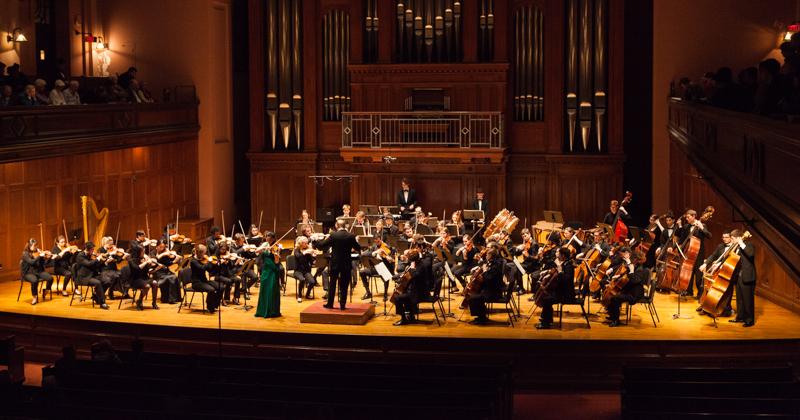Orchestra’s Synergy Eclipsed by Virtuosity
Photo by Bryan Rubin, Photo editor
Conservatory senior and soloist Yiran Chen performs Sergei Prokofiev’s Violin Concerto No. 2 in G Minor, accompanied by the Oberlin Chamber Orchestra. In their Saturday Finney Chapel concert, the orchestra performed a series of pieces ranging from Kodály’s whimsical Dances of Galánta to Sibelius’ somber “The Swan of Tuonela.”
April 15, 2016
With beautiful pieces and a talented ensemble, the Oberlin Chamber Orchestra made their mark on Finney Chapel Saturday night. Headlined by a performance of Sergei Prokofiev’s virtuosic Violin Concerto No. 2 in G Minor, Op. 63, the event highlighted the relationship between the soloists and the orchestra in each piece. The rapport within conductor Raphael Jiménez’s ensemble demonstrated a sense of equality that resembled a conversation between old friends. That said, this dynamic was inconsistent among the event’s three most prominent soloists. This musical expedition through the exceptionally un-Soviet music of Prokofiev, the Finnish cradle of Sibelius’ “The Swan of Tuonela” from Four Legends (Op. 22, No. 2) and the Hungarian festivities of Kodály’s Dances of Galánta provided the kind of awe-inspiring beauty that only well-orchestrated music can deliver. But for every dactyl of wordless poetry, there were several dialogues that, while intricately spoken, lacked the depth and intimacy that these works demand.
Prokofiev’s concerto began with violin soloist and Conservatory senior Yiran Chen’s lone melody. Soon, the grumblings of the orchestra formed into countermelodies that quietly accompanied at first before stepping wholeheartedly into a shared spotlight. At first, there seemed to be a balance and respect between the two forces. However, as the first movement progressed, it became difficult to clearly parse out the soloist’s music from the dozens of other violins in the orchestra. In some instances, the orchestra’s volume drew attention away from the soloist, but those were few and far between.
On the whole, the orchestra was the most interesting part of this piece. That’s not to say the soloist was unprepared or sloppy, but rather, the passionate and intimate core of this piece lived a few chairs behind where Prokofiev may have intended. Despite her technical proficiency, Chen never seemed to match the orchestra in clarity or intimacy. In a piece written by the Soviet enfant terrible of his time, the lack of any rebellion by the soloist undermines the essence of Prokofiev’s philosophy to create complex music for the masses without talking down to them.
By contrast, the raw energy of “The Swan of Tuonela” was overwhelming. From the outset, the lush melody enthralled, seamlessly transitioning from violin to English horn to cello. The whole orchestra seemed to be speaking as one, gloomily recounting a journey of mythic proportions. As minutes of slow tension and seamless, swelling crescendos flowed by, the texture of the piece shifted from romantic to tragic before offering brief glimmers of consonant resolution.
These moments of clarity were constantly retracted by the earthy drones of violins, satisfying one’s euphoric desires just long enough to leave a desire for more. Performed by a lesser orchestra, such nuances would come across as either too bright or bleakly oppressive. The Oberlin Chamber Orchestra and the expert solos of its English hornist, Conservatory junior Casey Kearney, successfully captured Sibelius’ complex cycle of hope and despair. In many regards, the English horn served as the narrator to this aural tale. As she described the basic necessities of the story, the orchestra filled in the remaining details, synthesizing two sides of the same story. The comfort with which the soloist and the orchestra played off of one another was a joy to hear.
This highlight of the concert appeared out of nowhere and disappeared in the blink of an eye but not without leaving its mark. Evoking lethargy upon its termination, the program transitioned to Kodály’s Dances of Galánta. Slow at first, the piece’s initial movement echoed the somber Sibelius that preceded it before transforming into a schmaltzy rondo and a playful festival dance afterward. The latter even caused several members of the audience to break into dance within the confines of their seats — that is, before their more conservative neighbors gave them the stink-eye of decorum, once again relegating the festivities to the stage.
One of the orchestra’s most notable achievements was its ability to seamlessly transition from the syncopated complexity of the more whimsical moments to the quaint simplicity of the slower dances and back within seconds. This was made all the more impressive by the gradual acceleration of the tempo during the piece’s second half. The balance of these elements was particularly striking, despite some weak points — namely, certain woodwind solos that underwhelmed throughout each movement. Some flute solos in the middle of the piece also lacked clarity, and many of the abundant clarinet solos seemed meek and unsupported. This led to odd moments when the string melodies preceding certain solos were vastly more passionate, sometimes jarringly so. But overall, there are few criticisms that can detract from the emphatic enjoyment provided by the string, brass and percussion during this dense piece’s 15-minute run.
Throughout its hour and a half on stage, the Oberlin Chamber Orchestra attempted to provide a wide selection of varying works, and for the most part, it succeeded. Though imperfect, what emerged was a satisfying, moving experience.


























